This site is made possible by its sponsors.
Please visit them!
art - For numerous reasons, the most difficult word to define without starting endless argument! Many definitions have been proposed. At least art involves a degree of human involvement — through manual skills or thought — as with the word "artificial," meaning made by humans instead of by nature. Definitions vary in how they divide all that is artificial into what is and isn't art. The most common means is to rely upon the estimations of art experts and institutions. More useful may be to see definitions of aesthetics, the arts, beaux-arts, craft, high art, and low art.
Also see quotations about art, including others' definitions of art.
art advocacy - See advocacy.
Art & Creative Materials Institute, Inc. (ACMI) - This is an international association whose members are over 210 art and creative (read: craft?) material manufacturers. Founded in 1940, ACMI is an authority on art and craft materials. Its principal goal is to assist its members in providing the public with art and craft materials for children and artists that are non-toxic or properly labeled with safe use information whenever the use of a product could present an adverse health effect. ACMI said in 2004 that, "Of the 60,000 art and craft material formulations evaluated to date, 100% of the children's products and 85% of those meant for the adult artist are certified as non-toxic. All products in the program undergo extensive toxicological evaluation and testing before they are granted the right to bear the ACMI certification seals."
ACMI's trademarked
certification seals — its health & safety labels:
The AP or Approved Products Seal — Non-Toxic
Products bearing the AP Approved
Products Seal are certified by the Art & Creative Materials
Institute (ACMI) to contain no materials in sufficient quantities
to be toxic or injurious to humans or to cause chronic or acute
health problems. These products are safe to use in the classroom,
even with young children. The statement "Conforms to ASTM
D-4236" indicates that the product conforms to the chronic
hazard labeling standard and the requirements of the Labeling
of Hazardous Art Materials Act (LHAMA). "If the product is
non-toxic, then no warning needs to be included on the label.
However, if the product is found to carry acute or chronic health
hazards, the information on the label must alert the consumer
to those hazards, and would carry a CL Seal if evaluated by ACMI."
The Consumer Product Safety Commission (CPSC) is the US federal agency charged with enforcing the Labeling of Hazardous Art Materials Act (LHAMA). The law requires art material labels to (a) carry a warning statement identifying chronic health hazards, (b) list the ingredients causing those hazards, and (c) provide directions for safe use of the product. The phrase, "Conforms to ASTM D 4236", is required as evidence that the guidelines of the standard were followed in the labeling of the product. The evaluation is to be conducted by a board-certified toxicologist, and the product must be reevaluated periodically, at least every five years. Another piece of information to be found on the label, as directed by the standard, is a source for additional information. This can take the form of a toll free phone number that is reachable 24 hours per day, or directions to contact a poison control center network. Under the Labeling of Hazardous Art Materials Act, it became a requirement for chronically hazardous products to carry the phone number of a person responsible for placing the product on the market. CPSC also enforces the Federal Hazardous Substances Act (FHSA), of which the LHAMA became a part and which regulates all consumer products for acute hazards.
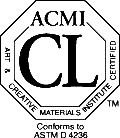
The CL or Cautionary Label -- Not
Recommended for Use with Children
Products bearing the CL Cautionary
Label Seal have health warnings associated with them and are not
recommended for use around young children. These products should
be used with caution and only by older children and adults.
Under US law, hazard-labeled products (CL Seal and warnings) may not be purchased for use by children grades pre-K through 6. These products are labeled "Keep Out of Reach of Children" and should not be used by young children, even with adult supervision, in schools. ACMI requires that all products meant for children's use and certified in its program be non-toxic. Only 15% of the adult materials ACMI has analyzed has been found to require hazard labeling.
Also see ASTM International (American Society for Testing and Materials), hazardous, Material Safety Data Sheet (MSDS), Occupational Safety and Health Administration (OSHA), poison, safety, science and art, seal, and Youth Art Month (YAM).
art appraisal - See appraisal.
art appreciation - See "appreciate and appreciation".The introduction of basic principles of visual literacy — especially the means to analyzing form without reference to subject matter, symbolism or historical context — to general audiences for the purpose of enhancing their enjoyment of works of art. Most contemporary art critics and art historians shy away from this term, disparaging art appreciation as demanding too little serious thought. Art educators must be forgiven for providing young students an easily digestible introduction to art. Nevertheless, given the poor reputation of art appreciation, any program of sophistication would better introduce students to art production, along with art in context and as inquiry: aesthetics, art criticism, and art history.
Also see iconoduly.
art brut - French for "raw art," Jean Dubuffet (1901-1985) devised this name in 1945 for the art of children and outsiders (naïve artists and the mentally ill); actually, anyone not producing art for profit or recognition. Because they did not adhere to the cultural norms or fashion effecting most artists, Dubuffet felt there was greater honesty and power inherent in the work of such people. His collection of art brut moved Dubuffet to cultivate such raw artistic elements in his own work, sometimes making pictures with pastes including mud, asphalt, or broken glass.
(pr. art broot)
An example of art brut:

Richard Dadd (English, 1817-1886), The Fairy Feller's Master-Stroke, 1855-64,
oil on canvas,
54.0 x 39.4 cm, Tate Gallery, London. After murdering his father
in 1843, Dadd was diagnosed as insane and spent the rest of his
life in asylums. Cut off from the outside world, he produced
a series of paintings which combine a remarkable attention to
detail with an individual, manic intensity. A fairy woodman stands
with his axe at the center of this composition, observed by numerous characters
from Shakespeare's play A Midsummer Night's Dream, including
the fairy king and queen Oberon and Titania, along with the fairy
Queen Mab, who rides in her chariot. The horror
vacui apparent in Richard Dadd's pictures may be a result
of his severe mental illness. See fantastic
and fantasy.
Examples of works inspired by art brut:

Jean Dubuffet (French, 1901-1985), Jazz band (dirty-style blues), 1945,
oil on canvas,
97 x 130 cm, Georges Pompidou Center, Paris.
Jean Dubuffet, Michel Tapié soleil (Michel Tapié Sun), 1946, gravel, sand, tow on hardboard, 110.2 x 87.8 cm, Georges Pompidou Center, Paris.
Jean Dubuffet, Dhôtel nuancé d'abricot (Dhôtel in Shades of Apricot), 1947, oil on canvas, 116 x 89 cm, Georges Pompidou Center, Paris.
Jean Dubuffet, La Métafisyx (The Metaphysic), 1950, oil on canvas, 116 x 89.5 cm, Georges Pompidou Center, Paris.
Jean Dubuffet, Gare Montparnasse Porte des Lilas, 1961, gouache, pen and ink and pencil on paper, 50 x 66 cm, Tehran Museum of Contemporary Art, Iran.
Also see Cobra, folk art, French art, naive art, obsession, outsider art, and primitive.
art buyer - The person who is a link between an agency and freelance artists; buys work for the agency.
Also see art careers, collector, and patron.
art center or arts center - Typically a group of buildings devoted to the exhibiting, teaching, and performance of the arts. Buildings may include an art gallery or museum, a performing arts theater, a fine arts library, a music building, and a dance studio.
art collective - See collaboration.
art conservator - In art conservation, a person who applies science to the technical study, preservation and treatment of art objects. A professional art conservator should be consulted about the display, storage, and preservation of special objects; about the preservation of public art and historic buildings and sites; about disaster planning for area prone to earthquakes, fires, or floods; when the surface of an object is either flaking, fading or discoloring; when an object is infested with insects or mold; before taking a textile or work on paper from its frame; and before doing an amateur cleaning or restoration. The immediately preceding article lists several art conservation resources. Also see art careers, cleavage, and preparator.
art critic - Among those in art careers, a person who describes, analyzes, interprets, evaluates, and expresses judgments of the merits, faults and value of artworks. One who produces art criticism.
Art about art critics:
Artists have depicted many specific art critics favorably, but artists seem rarely to have portrayed them as a group in a complimentary way.

Julio Ruelas (Mexican,
1870-1907), La Critica, c. 1900, ink drawing on paper for magazine illustration. Ruelas portrays the critic as demonic pest, a pince-nez and top hat wearing creature who's part rodent, part fowl, and induces pain with a needle nose — hardly an exemplar among practitioners of this craft! See Mexican art.

Raoul Hausmann (German, 1886-1971), The Art Critic, 1919-1920, photomontage and collage, 12 3/8 x 9 7/8 inches,
Tate Gallery, London. The Tate says, "Although the 'art critic' is identified by a stamp as George Grosz, another member of the [Dada] group, the image was probably an anonymous figure cut from a magazine. The fragment of a German banknote behind the critic’s neck suggests that he is controlled by capitalist forces."
About art critics:
Important art critics:
I apologize that this is a very limited, very tentative list — a list just begun, leaving numerous important art critics off the list. Return to find refinements soon! -MRD
art criticism - The description, analysis, evaluation, interpretation, and judgment of works of art. It is a common assumption that criticism is necessarily negative, when actually it can vary in degrees of positive as well as negative remarks. Critical methods vary considerably in their approaches to considering the forms, contents, and contexts of works of art.
There are several stages to critical analysis:
Art about art criticism:
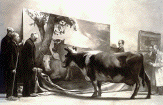
Mark Tansey (American, 1949-), The Innocent Eye Test, 1981, oil
on canvas, Metropolitan Museum
of Art, NY. Mark Tansey is known particularly for his monochromatic
paintings which are often humorous mock-historical scenes that refer to art historical subjects
and concern art criticism. This picture depicts a group of official
looking men observing and recording a
 cow's reaction to a life-size
painting of two cows in a pastoral
landscape.
The men are dressed in lab coats and business suits, and they
are all wearing eyeglasses, with the exception of one man holding
a mop — in anticipation of the cow's digestive progress. The
cow is looking
at an actual painting:
cow's reaction to a life-size
painting of two cows in a pastoral
landscape.
The men are dressed in lab coats and business suits, and they
are all wearing eyeglasses, with the exception of one man holding
a mop — in anticipation of the cow's digestive progress. The
cow is looking
at an actual painting: Paulus
Potter (Dutch, 1625-1654), The Young Bull, 1647.
Quotes:
Related resources:
Also see aesthetics, antiquarianism, argument, art appreciation, art careers, art conservation, art history, art theory, bias, connoisseur, deconstruction, description, design qualities, feminism and feminist art, formalism, gender issues, hermeneutics, iconography, interesting, Marxism, meaning, motivation, museology, patronage, periodicity, political correctness (PC), posthumous, praise, quotations, semiotics, structuralism, taxonomy, and theory.

Art Dealers Association of America (ADAA) - The Art Dealers Association of America (ADAA) is a non-profit membership organization of the nation's leading galleries in the fine arts. Founded in 1962, the ADAA seeks to promote "the highest standards of connoisseurship, scholarship and ethical practice within the profession." The ADAA members deal primarily in paintings, sculpture, prints, drawings and photographs from the Renaissance to the present day. The ADAA has 160 member galleries in more than 25 U.S. cities.
Also see art careers, commodification, gallerist, market value or market worth [or see monetary worth or monetary value or price].
art degree - An academic title given by a college or university to a student who has successfully completed a course of study. Sometimes such a degree is conferred as an honorary distinction.
Examples of art degrees: Bachelor of Arts (B.A.), Bachelor of Fine Arts (B.F.A.), Master of Arts (M.A.), and Master of Fine Arts (M.F.A.).
A joke [a bad joke]:
Also see articles about the various art professions, including architect, art appraiser, art buyer, art careers, art conservator, art critic, art director, art historian, artist, cartoonist, graphic artist, graphic designer, interior designer, etc. Also see webucation.
art director - Among those in art careers, a person who directs or supervises the work of other artists.
Also see applied arts, commercial art, graphic design, and specifications.
art district or arts district - A section of a community in which art galleries are situated near other art galleries, art museums, theaters, and music halls.
art elements - See elements of art or elements of design.
art engagé - French for "art involved in life." Art with a social or political significance.
Also see caricature, socialist realism, and social realism.
Arte Povera - Italian for "poor art," it was mostly sculptural work made from everyday materials including soil, cement, twigs, newspapers, instead of traditional materials like stone and bronze. This largely Italian movement, named by the critic Germano Celant in 1967, endured through the 1970s, concerned with metaphorical treatments to do with nature, culture, history, and contemporary life. Artists associated with Arte Povera include Jannis Kounellis, Mario Merz, and Michelangelo Pistoletto.
Also see bricolage.
art for art's sake - Any of several points of view related to the possibility of art being independent of concerns that order other disciplines. The term is primarily used regarding artists and artwriters of the second half of the nineteenth century, especially Charles Baudelaire (French, 1821-1867), James A. McNeill Whistler (American, 1834-1903) and Oscar Wilde (English, 1854-1900), and Edgar Allan Poe (American, 1809-1849). Here's a link to images of Whistler's The Peacock Room, 1876-77, Freer Gallery of Art, Washington, DC. The Peacock Room was once the dining room in the London home of Frederick R. Leyland, a wealthy ship owner from Liverpool, England. Leyland commissioned Whistler to paint the dining room. Between 1876 and 1877, Whistler brightened the room with golden peacocks, painting every inch of the ceiling and walls to create an elegant setting in which Leyland could display his blue-and-white porcelain as well as Whistler's painting The Princess from the Land of Porcelain.
Examples of art for art's sake below, begin with a preparatory study made for this painting:
![]()
James Abbott McNeill Whistler (American,
1834-1903, active England), Sketch for Rose and Silver: La Princesse du Pays
de la Porcelaine, 1863-64, oil
on fiberboard, Worcester Art Museum, MA. See orientalism
and study.
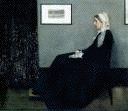
James Abbott McNeill Whistler, Arrangement in Grey and Black No. 1: Portrait
of the Artist's Mother, 1871, oil
on canvas, 4 feet 8 3/4 x
5 feet 3 3/4 inches, Musée d'Orsay, Paris, France. With
planes and shapes
flattened, and color
muted, Whistler's portrait demonstrates
his devotion to aestheticism and art for art's sake. Accordingly,
Whistler prefered to describe this paintings as an arrangement
— much as music is an arrangement of pure forms
— making him a precursor
to abstract art. See rectangle.

James Abbott McNeil Whistler), Nocturne in Black and Gold: The Falling Rocket,
c. 1874, oil on canvas,
23 3/4 x 18 3/8 inches, Detroit Institute of Arts. Whistler's
nocturnes were tangible demonstrations of his creed of aestheticism,
which stressed the artist's duty to orchestrate selected elements
from nature
into a composition
that, like music, existed
for its own sake, without regard to moral or didactic
issues. This controversial viewpoint led to a famous legal battle with John Ruskin (1810-1900, English
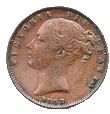 writer, critic, and artist). Whistler accused Ruskin of slander, when the critic published his opinion of Nocturne in Black and Gold: The Falling Rocket. Ruskin had written,"I have seen, and heard, much of cockney impudence before now; but never expected to hear a coxcomb ask two hundred guineas for flinging a pot of paint in the public's face." Whistler won the libel suit and the fine of one
writer, critic, and artist). Whistler accused Ruskin of slander, when the critic published his opinion of Nocturne in Black and Gold: The Falling Rocket. Ruskin had written,"I have seen, and heard, much of cockney impudence before now; but never expected to hear a coxcomb ask two hundred guineas for flinging a pot of paint in the public's face." Whistler won the libel suit and the fine of one farthing (the English coin of so little worth, it was eventually discontinued), and yet the affair bankrupted him. Also see fin de siècle, numismatics, and pyrotechnics.

James Abbott McNeil Whistler, Nocturne: The Thames at Battersea, 1878,
lithograph,
6 3/4 x 10 1/8 inches (17.1 x 25.7 cm), Metropolitan Museum of
Art, NY. See nocturne.
Quote:
Related resource:
Also see aestheticism, Art Nouveau, and fin de siècle.
![]()

![]()
art gum - An eraser that crumbles as it erases, not scratching or discoloring artwork.
Also see erasure.
artifact - An object produced or shaped by human craft, especially a rudimentary art form or object, as in the products of prehistoric workmanship. Only in the last ten or twenty years works of various native peoples been considered art rather than artifacts, and displayed in museums of art as well as of ethnography. In digital imagery, visual effects introduced into an image in the course of scanning or compression that do not correspond to the image scanned.
Also see collectible, ethnocentrism, material culture, placeholder, realia, and visual culture.
artificial - Made in imitation of nature by human beings rather than by nature; simulated. This may be intended and interpreted to carry either positive, negative or neutral ideas. A negative interpretation might imply lack of authenticity. Other synonyms with more specific meanings include synthetic (implying a chemical process) and ersatz (a German word for things that are obviously inferior). The term "artifice" can refer either to a thing which has artificial qualities, or to the means to making it.
A quote:
Also see collectible, copy, counterfeit, fake, forgery, original, reproduction, simulacrum, and truth.
artisan - A craftsman; a skilled manual worker.
Quote:
Also see art careers, artist, craft, craftsmanship, mystery, and virtuoso.
artistic development - See Stages of Artistic Development.
artistic temperament - A catch-all reference to artists' more peculiar attitudes, emotions, or behaviors which observers often attribute to being elements of artists' creative activities. Artists invariably do some things which non-artists find eccentric. Nevertheless, the concept of an "artistic temperament" may be too formless to define satisfactorily. And, it's too often used as an evasion of various issues difficult to confront.
Quote:
Also see achievement, bias, effort, motivation, and success.
 Artist Pension Trust (APT) - An organization offering a plan allowing artists to invest their own works toward a pension plan — eventual retirement income. APT's site says the organization, "is designed to meet specific needs of artists, a group whose career trajectories and employment patterns make existing pension programs inaccessible. APT helps ensure an artist's long-term fanancial secuity, allowing artists to focus on their work and take risks that are critical to their creative development." Here's basically how it works: beginning early in his or her career, a participant in APT contributes one work per year over a twenty year period to the tax-protected fund on the theory that some of the works will increase significantly in market value. All of the artists involved will share the profits, even if their initial promise never translates into increased market value. "It's a way of taking advantage of the capitalistic nature of the market and mix in a healthy dose of socialism to create a hybrid form," said David A. Ross, the former director of the Whitney Museum of Art and then the San Francisco Museum of Modern Art, who is the APT's president (quoted in the NY Times, July 20, 2004). APT hopes to establish trusts in ten cities, including New York, Los Angeles, Beijing, and Tokyo, with 250 artists participating in each. Visit their site, and contact them for more information.
Artist Pension Trust (APT) - An organization offering a plan allowing artists to invest their own works toward a pension plan — eventual retirement income. APT's site says the organization, "is designed to meet specific needs of artists, a group whose career trajectories and employment patterns make existing pension programs inaccessible. APT helps ensure an artist's long-term fanancial secuity, allowing artists to focus on their work and take risks that are critical to their creative development." Here's basically how it works: beginning early in his or her career, a participant in APT contributes one work per year over a twenty year period to the tax-protected fund on the theory that some of the works will increase significantly in market value. All of the artists involved will share the profits, even if their initial promise never translates into increased market value. "It's a way of taking advantage of the capitalistic nature of the market and mix in a healthy dose of socialism to create a hybrid form," said David A. Ross, the former director of the Whitney Museum of Art and then the San Francisco Museum of Modern Art, who is the APT's president (quoted in the NY Times, July 20, 2004). APT hopes to establish trusts in ten cities, including New York, Los Angeles, Beijing, and Tokyo, with 250 artists participating in each. Visit their site, and contact them for more information.
Also see art careers and artists' organizations.
artist-run organizations - See artists' organizations.
artists' books - Artworks in book form, not books about art, or art made of books. William Blake (English, 1757-1827) was among the first artists to create books with his own pictures and texts. Some artists' books have only pictures or only texts. Marcel Duchamp (French, 1887-1968) made some, beginning in the 1930s. Artists in many countries have produced them since the late 1960s, including Sol LeWitt (American, 1928-), John Baldessari (American, 1931-), Ed Ruscha (American, 1937-), and Anselm Kiefer (German, 1945-).
artist's bridge - A tool used to support the hand in order to keep it stable and clear of the working surface while drawing or painting fine passages.
Also see mahlstick.
artists' organizations - Also known as artist-run organizations, many are more commonly known as alternative spaces: non-profit galleries run by and for artists, which proliferated in American and other cities in the 1970s as independent organizations, considered necessary in an era of increasingly diverse artistic issues, experimentation, commodification, etc. — the museums and commercial galleries were seen as providing exhibition opportunities both too few and too tied to commodification. Alternative spaces championed feminism and ethnic diversity by presenting work by women artists and artists of non-European descent. By the early 1980s the nature of such organizations had diversified. Recent art school graduates could still find storefront venues for their installation, conceptual, video and performance art endeavors, but some alternative spaces had evolved into highly structured institutions with large staffs and funding from foundations, and government entities such as the National Endowment for the Arts (NEA). Representing them in Washington, DC, is the National Association of Artists' Organizations (NAAO).
Also see academy, American Academy of Arts and Letters (AAAL), American Watercolor Society (AWS), art careers, Artist PensionTrust (APT), College Art Association (CAA), National Art Education Association (NAEA), National Association of Independent Artists (NAIA), National Endowment for the Arts (NEA), and National Endowment for the Humanities (NEH),
artist's proof - One of a small group of prints set aside from an edition for an artist's use; a number of printer's proofs are sometimes also done for a printer's use. An artist's proof is typically one of the first proofs from a limited edition of prints, for the artist's own copyright use, and marked as an A.P., and not numbered. Artist's proofs generally draw a higher price than other impressions. The equivalent in French is épreuve d'artiste, abbreviated E.A.
artists with disabilities - See VSA arts.
art law -
About art law:
Also see copyright and First Amendment rights.
ArtPage, artlex, artlexicon, artlexical, artlexicographer, artlexicography - ArtPage is a word the author of this reference coined for the title of this art dictionary by compounding art and -lex (an abbreviation of lexicon) in 1996. (The study of origins and forms of names is called onomastics.) Several words (backformations) can be made from ArtPage. An artlex, then, is a short, common noun equivalent to art lexicon: any list of artwords; the art vocabulary, words, or morphemes of art language, especially an individual's mental collection of artwords. Artlexical is an adjective derived from artlex: of or relating to artwords; or having some relationship to artlexicography or an artlexicon. An artlexicographer is a person who defines artwords, or who writes an art dictionary. Artlexicography is the act of defining artwords, or of writing of a dictionary of them.
Art educators use artwords to facilitate students' learning about art — increasing knowledge of it, abilities to produce and discuss it, because a richer mental lexicon of artwords results in a more complex and functional web of connections between art media, techniques, artworks, visual culture, nature, and every other abstract and concrete thing in creation, resulting in an improved means of dealing with concepts involved in dialogue in the various artworlds — including those of artists, art critics, art historians, aestheticians, etc.
Art critics use artwords to describe, analyze, interpret, evaluate, and expresse judgments on the merits, faults and value of artworks.
Art historians use artwords to investigate, analyze, and interpret knowledge about the contributions artists and art have made to cultures and societies.
Also see iconography and iconology.
art movement - An artistic style or tendency seen in the intentions or works of a number of artists, because there is a striking similarity among the techniques, philosophy or goals they have embraced, or in the attitudes which they espouse in a (more or less) organized effort. Art movements have each thrived for a limited time — measured in a few months, years or decades. Postmodernism has produced a dearth of movements because its adherents practice such a divergence of styles.
Examples:
Quote:
Also see aesthetics, art criticism, fashion, isms and -ism, issue, movement (action), manifesto, new media, period, school, style, theme, theory, and time, as well as the names of various religiously, philosophically, ethnically, nationally, or geographically identified cultures.
art restoration - The work of repairing damage to artworks, bringing them back to their original condition. Unlike art conservation, this can admit the addition of elements which were not actually pieces of the original, but which are known to look just like them. Inpainting a portion of a painting that is damaged or missing, for instance.
Example:
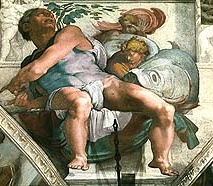
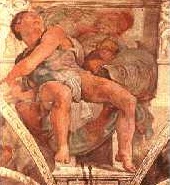
Michelangelo (born Michelangiolo Buonarroti) (Italian, 1475-1564), Ceiling of the Sistine Chapel, 1508-12, fresco, Vatican, Rome. This great work had been damaged by centuries of accumulated smoke, cracked and falling materials, and several previous restorations of dubious quality, when it was painstakingly conserved and restored in the 1990s. Each of these photos shows the figure of the Prophet Jonah: before and after this restoration work was done. See the Renaissance.
Related link:
Also see art careers, fragment, lacuna, and preparator.
the arts - Visual art, music, theater, and dance.
Images of the arts:

Jean-Baptiste Simeon Chardin (French, 1699-1779),
Still Life with the Attributes of the Arts,
1766, oil on canvas,
44 x 55 inches (112 x 140.5 cm), Hermitage Museum, St. Petersburg,
Russia. See still
life.
Quotes about the arts:

Related link:
Culturekiosque.com is an online journal of arts and culture based in Europe and covering the arts and museum scene worldwide.
Also see advocacy, architecture, art, civilization, effort, graphic arts, heritage, muse, Prometheus, and universal artwork.
Arts Education Partnership (AEP) - The Arts Education Partnership (formerly the Goals 2000 Arts Education Partnership) is an American national coalition of arts, education, business, philanthropic and government organizations that demonstrates and promotes the essential role of the arts in the learning and development of every child and in the improvement of America's schools. The Partnership includes over 140 organizations that are national in scope and impact. It also includes state and local partnerships focused on influencing education policies and practices to promote quality arts education. Partnership organizations affirm the central role of imagination, creativity and the arts in culture and society; the power of the arts to enliven and transform education and schools; and collective action through partnerships as the means to place the arts at the center of learning. Contact:
Arts Education Partnership
One Massachusetts Avenue, NW, Suite 700
Washington, DC 20001-1431
Information Line: (202) 326-8693
Fax Number: (202) 408-8081
aep@ccsso.org
Also see advocacy.
art therapy - The therapeutic use of art making, within a professional relationship, by people who experience illness, trauma, or challenges in living, and by people who seek personal development. Through creating art and reflecting on the art products and processes, people can increase awareness of self and others, cope with symptoms, stress, and traumatic experiences; enhance cognitive abilities; and enjoy the life-affirming pleasures of making art. A study by L. DePetrillo and E. Winner (Journal of the American Art Therapy Association, 2005, 22, 4), showed that producing art improves mood for some through catharsis and for others through redirection.
Art therapists are professionals trained in both art and therapy. They are knowledgeable about human development, psychological theories, clinical practice, spiritual, multicultural and artistic traditions, and the healing potential of art. They use art in treatment, assessment and research, and provide consultations to allied professionals. Art therapists work with people of all ages: individuals, couples, families groups and communities. They provide services, individually and as part of clinical teams, in settings that include mental health, rehabilitation, medical and forensic institutions; community outreach programs; wellness centers; schools; nursing homes; corporate structures; open studios and independent practices.
Related links:
Also see achievement, art careers, blocks to creativity, creative self-expression, creativity, effort, finger paint, gestalt, interdisciplinary, motivation, praise, science and art, standards, and talent.
artwork - A general term referring to any artistic production. Sometimes, like oeuvre, it can also signify an entire body of works. Related terms include artifact, commodity, object, piece.
Also see masterpiece and signature.
art world or artworld - A sphere of activity or a sub-culture maintained by people whose identity is drawn in some way to or from art.
When spoken of as the artworld, this art sub-culture is the contemporary network of art specialists who are most influential. This community is also called the "mainstream art world." When artworld is preceded by "an," as when reference is made to an artworld, the art sub-culture is a group of people who loosely or formally associate with each other because they are familiar with and agree with some similar art values and ideas. They may engage in, or are familiar with, some of the same art activities.
Around the world and through the ages there have been many diverse artworlds. An artworld might be as large as the European artworld, or the twentieth century artworld. Examples of smaller artworlds are: the Italian Renaissance artworld, the sixteenth century Incan artworld, the court artworld of Sung Dynasty China, the ceremonial artworld of the Kuba people of West Africa, the contemporary gallery artworld in Los Angeles, and the artworld of graphic design. The shared information, values, and activities that define these artworlds vary tremendously. Values and criteria upheld in one artworld may not be prized in another. Investigating an unfamiliar artworld opens up avenues for gaining insights into unfamiliar, otherwise seemingly incomprehensible, or not-easily-appreciated artworks made within that unfamiliar artworld.
Examples of more narrowly focused artworlds: the current ice-sculpting artworld, the artworld of Romanian art conservators, or the traditional pottery-making artworld of Pacific islanders.
Although "art world" is the more universally recognized form of this term, "artworld" is frequently employed by artworld insiders.
Quote:
Also see art careers, art history, artists' organizations, context, culture, elitism, ethnocentrism, knowledge, motivation, outsiders, and theory.
https://inform.quest/_art